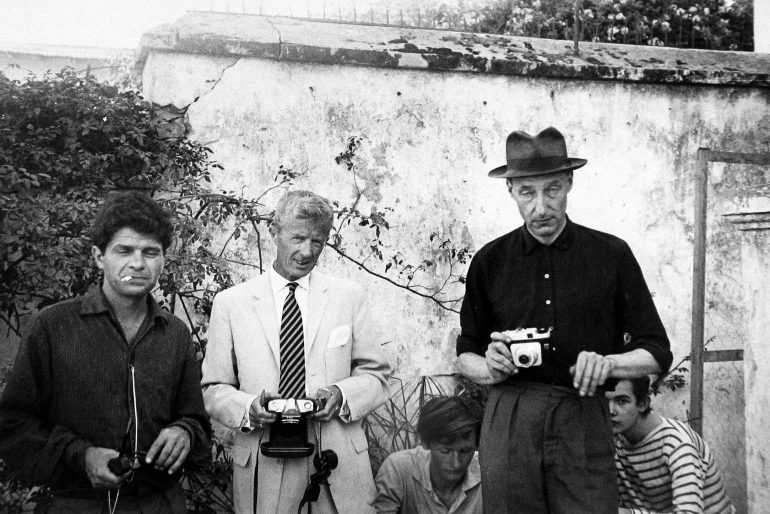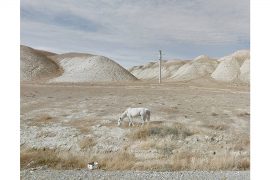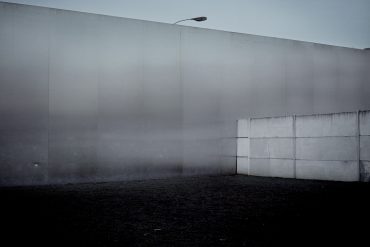di Claudia Stritof
_
Provocative, ironic, biting. Many could be the adjectives to describe Allen Ginsberg, the prophet of the Beat Generation; but what is the use of giving sterile labels to such a multifaceted personality?
Allen Ginsberg shuns any category and finds a thousand different accents; it would be impossible to call him just a poet, because he was also a respected intellectual, a mentor to many, a man always willing to learn, an activist and defender of human rights and, last but not least, a passionate photographer. Activities that cannot be separated, because they are the direct emanation of his highly refined sensitivity aimed at revealing the fleeting social superstructures that distance individuals from a genuine experience of the world.
Going through Allen Ginsberg’s family album means being on the road from India to Morocco, from Italy to America, passing through Mexico, France, Kenya and the many other countries he visited; savouring the atmosphere experienced by the young people of the time, understanding the intellectual exchanges that led to the creation of great Beat Generation masterpieces and seeing the faces of the greatest “beautiful minds” of American counterculture: Jack Kerouac, Neal Cassady, William Burroughs, Lawrence Ferlinghetti and so on.

Ginsberg’s passion for photography was born by chance in 1953, when he bought a second-hand Kodak to photograph the moments spent in the company of friends, colleagues and acquaintances.
Those were the years when Ginsberg composed and published the exceptional Howl, a journey into the fervent mind of the author and a strong protest against a conservative and corrupt America, written with direct and brutal words, free from the pomp of contemporary poetry.
As the Beat Generation enthusiast Fernanda Pivano, who first edited the Italian translation of the poem for the Jukebox all’Idrogeno collection published by Mondadori in 1965, wrote: “Howl […] is made up of bare and pure verses, based above all on rhythm, and, in a certain sense, working-class.”
Pivano defines them as “bare and very pure”, “working class” verses; three adjectives that could refer to Ginsberg’s photographs, as well. Photographs that are the result of the poet’s absolute closeness to the subjects, that do not hide anything of the reality they experienced, which shows a spontaneous use of the medium and certainly no artistic ambitions.

Ginsberg’s relationship with photography has been extensively investigated since his first exhibition, held at the Holly Solomon Gallery in New York in 1984. The intimate and colloquial language of the images that emerge from the exhibition is the result of Ginsberg’s direct relationship with his subjects, an aspect also underlined by the presence of long captions on the frame of the photographs handwritten by Ginsberg himself.
Not to be missed is the portrait of Gregory Corso, “Poetus Magnus”, dressed as a magician in his Parisian attic in 1957; that of Paul Bowles and Christopher Wanklyn in Marrakech in 1961; the many shots taken in India, during the long journey with his poet friend Peter Orlovsky and also worth mentioning is the beautiful photograph taken in Tangier, which sees Orlovsky and Jack Kerouac as unusual bathers, while William Burroughs is lying on the beach.
Allen Ginsberg was not used to talking about his life, despite this, his literary works and his photographs tell us a lot about his existence and his story, confirming the journal nature of his corpus of work, animated by the desire to “capture a few moments” taken out of the vortex of existence.
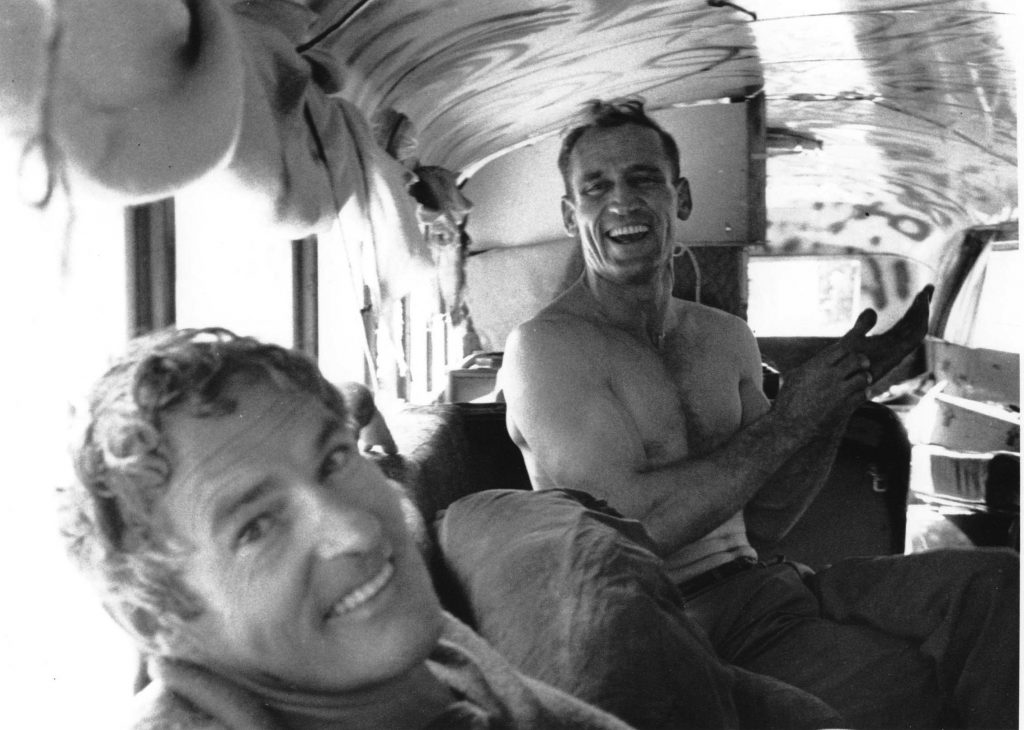
Around 1963, Allen Ginsberg – now completely taken by literature – abandons photography, to rediscover it later, in 1984, the year to which the captions on the images also date back.
It was his assistant at the time, Raymond Foye, who told, in a long interview with John Shoesmith for the Allen Ginsberg project, about the discovery of the films in the poet’s archives, at the time in storage at the Butler Library of Columbia University.
Ginsberg had forgotten the films and, seeing them, he was pleasantly surprised, both for the high quality of the images – perfectly in line with the aesthetics of the 80s – but above all for their content, because inside those film rolls there was the entire story of the Beat Generation told not by someone outside the movement but by those who created it.
The interest and appreciation shown by critics and audience revived Ginsberg’s love for photography, who then, on the advice of his friend and photographer Robert Frank, bought a Leica and a Rolleiflex, also recommended by Berenice Abbott and Hank O’Neal.
In those years he mainly took photographs of his friends and, among the portraits, we obviously find those of his teachers Frank and Abbott, of Francesco Clemente, Bob Dylan and Philip Glass, the composer with whom, shortly before his death (in 1997), he recorded the beautiful Ballad of the Skeletons, which featured, in addition to Glass, Lenny Kaye, Marc Ribot and Paul McCartney, with a video directed by Gus Van Sant.
Ballad of the Skeletons reaffirmed Ginsberg’s opposition to government politics and, taking inspiration from the traditional Mexican festival, harshly attacked the vanity of contemporary society.
Poetry, music, television, radio, publishing: every medium was used by Ginsberg to spread his thought and express his intellectual freedom and, in this process, photography, as a sign of conscious presence in the world, was no exception.
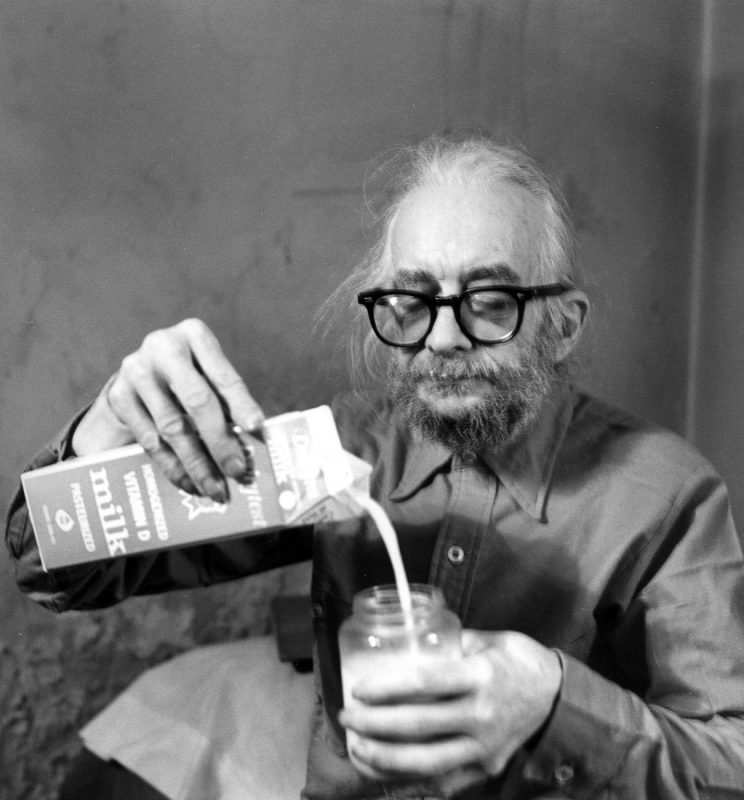
In conclusion, I would like to mention the beautiful portrait of Harry Smith, painter, archivist, anthropologist, director and alchemist, considered by many to be a genius, by others a charlatan, he was one of the most important personalities of the Beat group. Ironic and surreal, this is how Ginsberg remembers him in the famous photograph taken while “Harry turns milk into milk.”
A tautological operation for a shrewd photography that well conveys the personality of the subject, as well as the irony and genuineness of Ginsberg, a sensitive interpreter of the world and poet of existence.
As he said: “poetry is not an expression […]. It’s that time of night, lying in bed, thinking what you really think, making the private world public, this is what the poet does”; and this is what Ginsberg did: he made it possible to believe that the cultural solidity of a person can be an intellectual weapon to be used against the rampant indifference in our daily life.
More on Allen Ginsberg’s work:
https://allenginsberg.org
IG: https//www.instagram.com/allenginsbergofficial/?hl=en
March 29, 2021
